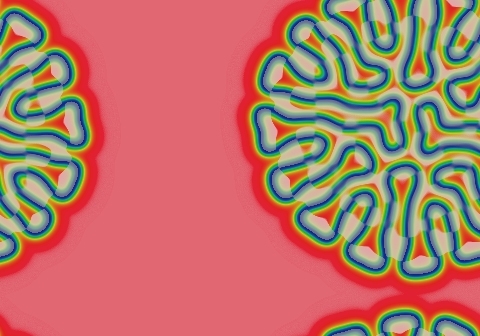Gray-Scott Model at F 0.0620, k 0.0630
These images and movie demonstrate the behavior of the Gray-Scott reaction-diffusion system with σ=Du/Dv=2 and parameters F=0.0620, k=0.0630.
Here a simple symmetrical starting loop grows into a convoluted form while remaining as a single closed loop, much like a Hilbert curve. Multiple loops generally remain separate while growing. As the space is filled, worm tips emerge from bends and lines shift to become more parallel. Most of the structure seen here remains after 1,250,000 tu.
Not shown here, a worm in isolation grows rapidly at the ends into a coral, with tips branching repeatedly and curving back upon themselves.
At F=0.0620, loops grow when k is about 0.0644 or less; above this k value (further east) they shrink to solitons.
Categories: Pearson κ; Wolfram 2-a (glossary of terms)
 increase F increase F
 | |||
 decrease k  |


|
15 frames/sec.; each fr. is 159 iter. steps = 79.5 tu; 1800 fr. total (143,100 tu) |  increase k 
|

|


| ||
 decrease F decrease F
 |
In these images:
- Color indicates level of u, ranging from purple (lowest u values) through blue, aqua, green, yellow and pink/red (highest u values)
- Areas where u is increasing are lightened to a light pastel tone; where u is decreasing the color is vivid.
- In areas where u is changing by less than ±3×10-6 per tu, an intermediate pastel color is seen. This includes areas that are in steady state or equilibrium.
''tu'' is the dimensionless unit of time, and ''lu'' the dimensionless unit of length, implicit in the equations that define the reaction-diffusion model. The grids for these simulations use Δx=1/143 lu and Δt=1/2 tu; the system is 3.2 lu wide. The simulation meets itself at the edges (periodic boundary condition); all images tile seamlessly if used as wallpaper.
Go back to Gray-Scott pattern index
This page was written in the "embarrassingly readable" markup language RHTF, and was last updated on 2019 Jan 05.
 s.11
s.11